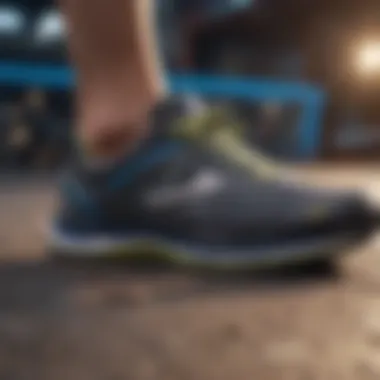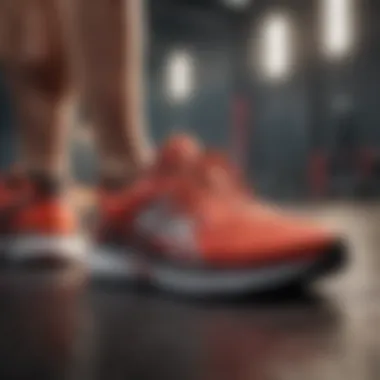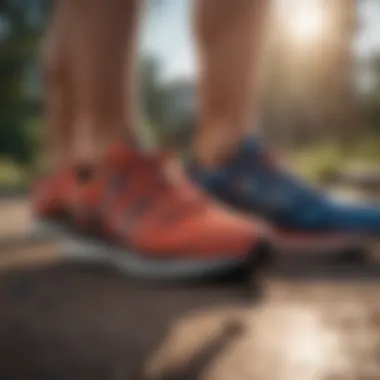Top High Arch Running Shoes for Men in 2023


Intro
Finding the right running shoes is crucial for performance and injury prevention, especially for runners with high arches. High arches can cause unique challenges. Many people with high arches often experience discomfort, which can lead to a less effective running experience. It is vital to choose shoes that provide adequate support and cushioning.
This article will explore various shoe options available on the market. It will assess key features that need to be considered when selecting proper footwear for high arches. We will delve into popular brands and models that cater specifically to this need. In addition, you will find tips on maintaining running shoes to ensure their longevity. By understanding the requirements for high arches, runners can make informed decisions, ultimately improving their performance.
Key Takeaways
- Support and Stability: Choosing shoes with adequate cushioning is essential for runners with high arches.
- Important Features: When selecting shoes, consider arch support, heel height, and shock absorption to ensure a comfortable run.
- Recommended Brands: Brands like Brooks, Asics, and Hoka One One offer models specifically designed for high arches.
- Maintenance Tips: Proper care can prolong the life of running shoes, optimizing your investment.
In-Depth Analysis
Understanding the structure of the foot is paramount. Runners with high arches lack adequate flexibility in the foot's arch. This rigidity may result in shock not being effectively absorbed during running. The result can be pressure on the knees, hips, and back.
Scientific Insights
Studies indicate that individuals with high arches are more prone to conditions such as plantar fasciitis, stress fractures, and Achilles tendinitis. The right footwear can mitigate these risks by providing the necessary support.
A research published in the Journal of Foot and Ankle Research supports the notion that appropriate running shoes significantly reduce injury rates for high-arched runners.
Features to Consider
- Arch Support: Ensure the shoe has adequate support specifically designed for high arches.
- Cushioning: Look for shoes with superior cushioning to assist in shock absorption.
- Fit: A proper fit is essential. Shoes that are too tight or too loose can contribute to discomfort.
- Weight: Optimal shoe weight can enhance performance. Lightweight shoes allow for faster runs but ensure they still provide the necessary support.
Pro tip: There are insoles specifically designed for high arches that can augment comfort, giving extra support where needed.
"Choosing the wrong shoes can exacerbate foot issues, leading to poor performance and injuries."
By selecting shoes that meet the unique needs of high arches, runners can significantly improve their running experience while minimizing injury risk.
Understanding High Arches
Understanding high arches is crucial for runners who wish to prevent injuries and improve their performance. High arches imply that the feet have an exaggerated curve, which can affect the way weight is distributed during running. This can lead to unique challenges and demands when selecting running shoes. The arch is fundamental for stability and helps absorb shock. Therefore, recognizing the characteristics of high arches can guide individuals to make informed footwear choices, minimizing the risk of stress-related injuries.
What Are High Arches?
High arches, also known as pes cavus, refer to a condition where the arch of the foot is elevated higher than normal. This anatomical structure can vary significantly among individuals. A high arch can lead to limited flexibility and may cause extra stress on various parts of the foot, including the heels and balls. Those with high arches may notice their feet roll outward when walking or running, which can affect balance and alignment.
Causes of High Arches
The causes of high arches can be diverse, stemming from both genetic and structural factors. Some individuals are born with this foot structure. Others may develop high arches due to conditions such as neuromuscular disorders, which can affect muscle control. Injuries or conditions that impact the nerves and muscles in the foot can also lead to the formation of high arches. In certain cases, overuse of the foot during physical activities can contribute to this issue.
Impact on Running
The impact of high arches on running can be significant. Runners with high arches often experience a different gait than those with more neutral arches. This difference can lead to uneven wear on shoes and potentially to injuries like plantar fasciitis, shin splints, and ankle strains. The heightened arch may result in less shock absorption, increasing the impact on joints. Furthermore, receiving proper arch support from running shoes is vital for maintaining proper alignment and overall comfort during runs.
Why Proper Footwear Matters
Selecting the right running shoes is critical for runners with high arches. This footwear not only supports their unique foot structure but also plays a significant role in overall performance and injury prevention. Many runners underestimate the relationship between their shoes and their physical well-being. The best high arch running shoes are designed to accommodate specific needs, ensuring comfort during runs and minimizing the risk of chronic issues such as plantar fasciitis or metatarsalgia.


The Role of Running Shoes
Running shoes serve as a vital interface between the runner and the ground. They contribute to cushioning impact during every foot strike. For those with high arches, adequate support is even more essential. This is because their foot type typically leads to increased pressure on the ball and heel of the foot. The right shoes will offer the correct arch support to distribute weight evenly.
A shoe featuring adequate support systems ensures that energy is returned efficiently with each stride. Moreover, many high arch shoes include midsole technologies that enhance cushioning while providing stability and flexibility. Runners should consider shoes that enhance both comfort and performance, giving them confidence in every footfall.
The Consequences of Wrong Choices
Choosing inappropriate footwear can have long-term effects on a runner's health. Ill-fitting shoes can lead to a number of problems. Some of the more common issues include blisters, shin splints, and knee pain. The shoes may not provide the required support, leading to insufficient shock absorption.
Additionally, incorrect footwear could result in poorer running form. This may further exacerbate underlying foot problems, leading to strains and discomfort. It is crucial for runners to invest time in choosing the correct pair of shoes that align with their high arch needs.
"The right shoes are not merely an accessory; they are a fundamental component of a runner's performance and well-being."
Neglecting to prioritize proper footwear can have dire consequences. Runners experiencing ongoing pain or discomfort should reflect on their shoe choices, as it might be the source of their challenges. Well-informed decisions regarding footwear can lead to improved performance, increased enjoyment in running, and lasting health benefits.
Key Features for High Arch Running Shoes
Choosing the right footwear is essential for runners with high arches. Different aspects influence a shoe's effectiveness, impacting both performance and injury prevention. This section outlines key features that are vital when selecting high arch running shoes. The goal is to enhance comfort while ensuring proper support.
Arch Support
Arch support is perhaps the most crucial feature for high arch runners. Proper support helps distribute pressure evenly, reducing strain on the feet and legs. High arches often lead to discomfort and injury without adequate support. A shoe designed with a built-in arch support contours the foot's natural shape. This alignment minimizes the risk of conditions like plantar fasciitis or shin splints. Runners should look for shoes with a firm heel counter and a slightly elevated arch area. These aspects promote stability during runs.
Cushioning Materials
The choice of cushioning materials also plays a significant role. Shoes should feature responsive and durable foams that absorb impact effectively. Technologies such as EVA (ethylene-vinyl acetate) or gel inserts often provide excellent shock absorption. Not only does this improve comfort, but it also enhances performance by allowing for longer runs without fatigue. Pay attention to shoes that combine soft cushioning with a firmer base. This combination caters to the needs of high arch runners, offering both comfort and support.
Stability Features
Stability features are essential for controlling excess movement. High-arch runners sometimes experience overpronation—where the foot rolls inward excessively. Stability shoes include various technologies, such as medial posts or dynamic support systems, that help manage this motion. These features contribute to a more balanced gait and can prevent injuries associated with improper foot movement. Look for options that are not overly rigid but still provide ample support for high-arch needs.
Breathability
Breathability is another key feature that often gets overlooked. High-intensity running can generate excessive heat and moisture in shoes, leading to discomfort. A well-ventilated shoe allows air to circulate, keeping the feet cooler and drier. Look for mesh uppers or moisture-wicking materials that enhance airflow. This is especially important for long-distance runners, as sweat accumulation can lead to blisters and other foot issues. Choosing breathable shoes can improve overall running experience and reduce the risk of wake-related issues.
Popular Brands Overview
The importance of familiarizing oneself with well-known brands when choosing running shoes for high arches cannot be overstated. Each brand brings its unique approach to design and technology, catering to the specific needs of runners with high arches. By exploring these popular brands, runners can make informed decisions based on features such as comfort, longevity, and performance enhancement. Additionally, reputable brands often invest in research and development to create shoes that accommodate various types of biomechanical needs, which can be critical for avoiding injuries associated with high arches.
Popular brands like Asics, Nike, Brooks, Saucony, and New Balance have carved niches in the footwear industry by establishing trust through consistent quality and customer satisfaction. Understanding their offerings can lead to significant benefits when selecting the right shoe, ensuring that it meets the demands of high-arch runners.
Asics
Asics is a brand celebrated for its dedication to creating shoes that enhance athletic performance while offering necessary support. The Gel technology incorporated into its shoes provides substantial cushioning, which can be vital for runners with high arches. The Asics Gel Kayano, for instance, is a popular choice among those who need both comfort and support. It features a resposive midsole and an upper that offers breathability, adding to overall performance during runs. Asics has established a loyal following due to its commitment to technological advancements and quality.
Nike
Nike is among the most recognized names in athletic footwear. Their running shoes are designed using advanced technologies that focus on comfort, innovation, and style. Shoes like the Nike Air Zoom Pegasus are specifically engineered to provide adequate support for high-arched feet. The Zoom Air units enhance responsiveness, making them suitable for both casual runners and those looking to improve their speed. Furthermore, Nike’s array of options appeals to a broad range of preferences, from aesthetics to performance features, allowing runners to choose footwear that reflects their personality and needs.


Brooks
The Brooks brand prides itself on its focus on the running community, and it emphasizes the importance of fit. Shoes like the Brooks Ghost are known for their soft cushioning and smooth transitions, which can be helpful for those experiencing discomfort due to high arches. Brooks also invests in research to better understand how different foot shapes and running habits affect performance, leading to shoes that cater specifically to these needs. Their dedication to running makes them a reliable option for athletes looking for tailored features.
Saucony
Saucony is another brand that has gained popularity among serious runners. The Saucony Ride series, for example, offers a balanced mix of cushioning and responsiveness. This combination ensures that runners with high arches experience minimal strain during their runs. Saucony’s shoes are often praised for their durability and adaptability to various running styles. Their emphasis on providing a light and responsive shoe can be beneficial for runners who seek speed without sacrificing comfort.
New Balance
New Balance stands out in the market for its commitment to customization and fit. It offers an array of widths, which can be incredibly advantageous for runners with high arches needing a precise fit. The New Balance Fresh Foam series is designed to provide plush cushioning while still maintaining stability. This blend of comfort and support makes it a suitable choice for high-arch runners who accumulate miles over time. New Balance’s focus on ergonomics allows for an enhanced running experience, which is pivotal for injury prevention.
Top High Arch Running Shoes for Men
Selecting the right running shoes is crucial for individuals with high arches. These shoes must meet specific requirements to provide adequate support and comfort. A well-designed shoe can immensely enhance performance while minimizing the risk of injuries. Runners with high arches often face issues like instability and uneven weight distribution. Thus, the best shoes for them not only offer support but also sufficient cushioning to absorb impact. Here, we explore some of the top options available in the market, focusing on their special features and benefits.
Asics Gel Kayano
The Asics Gel Kayano is highly regarded for its stability and cushioning. Suitable for overpronators, this shoe features a Dynamic DuoMax Support System that enhances support and increases stability without compromising comfort. The Gel technology effectively absorbs shock, reducing the stress on high arches during runs. Moreover, the breathable mesh upper ensures proper ventilation, keeping the foot cool. The Asics Gel Kayano is an excellent choice for runners looking for both performance and comfort in their high arch running shoes.
Nike Air Zoom Pegasus
Nike Air Zoom Pegasus offers a balance of comfort, responsiveness, and durability. This shoe uses a full-length Zoom Air unit that provides excellent cushioning. The lightweight construction helps runners maintain speed without sacrificing support. Furthermore, the innovative design includes a breathable upper that conforms to the foot, offering a snug fit. For those with high arches, the shape of the Pegasus allows for natural foot movement, making it a favorite amongst many runners.
Brooks Ghost
The Brooks Ghost is known for its plush cushioning and smooth ride. It features BioMoGo DNA cushioning that adapts to the runner's stride, offering support precisely where it is needed. The segmented crash pad ensures that transitions between heel strike and toe-off are seamless, which is vital for high arch runners who may experience foot strain. With a roomy toe box, this shoe allows for natural toe splay, further enhancing comfort during long runs.
Saucony Ride
Saucony Ride is another top contender in the category of high arch running shoes. Its PowerGrid cushioning technology delivers a well-balanced feel, ideal for runners seeking comfort and responsiveness. The shoe has a lightweight design and a durable rubber outsole that improves traction on various terrains. Additionally, the breathable mesh upper helps keep feet dry and comfortable over longer distances, ensuring a pleasant running experience.
New Balance Fresh Foam
The New Balance Fresh Foam line is specifically engineered to offer plush cushioning while maintaining stability. With its unique Fresh Foam midsole, it provides a soft landing and a smooth ride. This model is particularly beneficial for runners with high arches as it disperses impact effectively. The bootie construction offers a snug fit, and the added support helps minimize the strain experienced during runs. New Balance Fresh Foam keeps runners feeling fresh on their feet, making it a wise choice for long-distance training.
Choosing the right running shoe can significantly affect a runner's performance and comfort levels. It is important to assess personal needs when selecting footwear.
Selecting the Right Size
Selecting the right size for your running shoes is not just a minor detail; it is a critical factor that can significantly impact comfort and performance. When it comes to high arches, this aspect gains even more importance. A proper fit can alleviate discomfort, enhance stability, and reduce injury risk. Conversely, an incorrect size can lead to blisters, calluses, or even more severe issues such as plantar fasciitis. Therefore, understanding how to measure your feet and what constitutes a good fit is essential for all runners, particularly those with specific needs like high arches.
Measuring Your Feet
Measuring your feet is the first step towards finding the ideal running shoes. Many people make the mistake of assuming their shoe size and purchasing based on past experiences or general sizes. To ensure accuracy, it is advisable to measure both feet, as one foot may be larger than the other.
- Gather Your Materials: You need a ruler or measuring tape, a piece of paper, and a writing instrument.
- Prepare the Surface: Stand on the paper, ensuring your heel is against a wall.
- Outline Your Foot: Trace around your foot. Ensure that the pencil remains upright to get the most accurate outline.
- Measure the Length and Width: Use the ruler to measure the longest and widest parts of your foot. Record these measurements.
- Consult Size Charts: Use the measurements to match with the specific size chart of the shoe brand you are considering, as sizes can differ between brands.
By taking these steps, you can reduce the chances of buying shoes that are too tight or too loose, ultimately leading to a more enjoyable running experience.


Fit for High Arches
In addition to length and width, the overall fit is critical when selecting running shoes for high arches. Buyers should focus on how the shoes accommodate the unique arch structure.
- Check Arch Support: Ensure that the shoes provide adequate arch support. This helps distribute weight and can prevent discomfort during runs.
- Heel Cup: A deep heel cup can help with stability and prevent excessive movement within the shoe, which is crucial for maintaining proper form.
- Flexibility: Look for a shoe that offers both flexibility in the forefoot and structure in the arch area. This balance is necessary for effective movement.
- Try Before You Buy: If possible, try the shoes on while wearing the socks you typically use when running. Walk around and perform a few light strides to get a real feel of the shoe.
Proper fit for high arches can enhance not only your running performance but also your overall foot health.
Selection of the right size, combined with features noted above, sets a firm foundation for effective and enjoyable running for men with high arches.
Maintaining Your Running Shoes
Maintaining your running shoes is a crucial aspect that often gets overlooked. Proper care extends the functionality and lifespan of high arch running shoes, ensuring they continue to provide the support needed for effective running. This section outlines specific elements and benefits that demonstrate the importance of regular maintenance.
Taking the time to care for your shoes can lead to improved performance and a reduced likelihood of injury. High arches require specific support and cushioning; wear can diminish these qualities significantly. Here are some key points to consider:
- Performance: Well-maintained shoes perform better, allowing you to run efficiently, thus enhancing your overall performance.
- Injury Prevention: Regular upkeep helps spot wear and tear early, which might otherwise lead to injuries such as bunions or plantar fasciitis.
- Cost-Effectiveness: It is often cheaper to maintain a good pair of running shoes than to continuously replace them.
In essence, maintaining running shoes is not just about aesthetics. It is intertwined with your running health and overall athletic performance.
Cleaning and Care Tips
Proper cleaning and care are essential to the longevity of your running shoes. Here are some effective tips that can be easily incorporated into your routine:
- Remove Mud and Dirt: After running, gently remove mud and dirt with a soft brush. Avoid using harsh chemicals which can damage materials.
- Air Dry: If your shoes are wet, allow them to air dry at room temperature. Never use heat sources such as radiators or direct sunlight, as these can warp the materials.
- Wash Sparingly: Only wash your shoes in the washing machine if recommended by the manufacturer. Use a gentle cycle and place them in a mesh bag to protect them.
- Use a Shoe Tree: Incorporating shoe trees can help maintain the shape and prevent creasing.
- Rotate Shoes: If possible, alternate between multiple pairs of running shoes to allow each pair to recover between uses.
Following these tips not only keeps your shoes in prime condition but also enhances your running experience by ensuring they are comfortable and supportive.
When to Replace Shoes
Recognizing when to replace your running shoes can be challenging, yet it is imperative. Several factors contribute to the need for replacement, which is vital for maintaining optimal foot support. Here’s a guide on when to consider a new pair of high arch running shoes:
- Mileage: As a general rule, running shoes should be replaced every 300 to 500 miles. Monitor how many miles you have run, and use this as a benchmark for replacement.
- Visible Wear: Check the sole for signs of wear or tread loss. If the cushioning appears compressed or the outsole is uneven, it is time to replace them.
- Discomfort: If you start feeling aches or discomfort in your feet, knees, or back during or after running, it may indicate that your shoes are no longer providing proper support.
- Structural Integrity: Inspect for any bulges or deformities in the shoe. If the shoe looks deformed or the fabric starts to rip, then you should consider replacement.
"Maintaining certain practices concerning your shoes can markedly reduce incidence of runner's injuries."
By replacing worn-out shoes in a timely manner, you will not only preserve your performance but also minimize the risk of injury, allowing you to enjoy running to its fullest.
End
Choosing the right footwear is crucial for runners with high arches. This article has explored various aspects of high arch running shoes, highlighting the specific characteristics and features that these shoes should possess. By understanding the needs of those with high arches, we can guide them in selecting shoes that enhance running performance and minimize the potential for injuries.
Footwear designed for high arches typically includes features such as excellent arch support, effective cushioning, and optimal stability. These characteristics are important because they support the foot during impact and provide comfort over long distances. Choosing shoes that fit well and are suited to one's specific running style can make a significant difference in one’s experience.
"The key to successful running with high arches lies in the right pair of shoes."
Moreover, the discussion of popular brands has provided insights into the options available, empowering readers to make informed choices. Each brand brings unique technology and design philosophy, which can cater to individual runner’s preferences.
Finally, it is essential to emphasize ongoing maintenance of running shoes. Proper care and knowing when to replace them can prolong their life, ensuring continued support during runs. The knowledge shared in this article will enable runners with high arches to select appropriate shoes and maintain them for better running experiences.
Final Thoughts on Choosing Footwear
Ultimately, choosing the right footwear involves a thoughtful examination of one’s personal running needs. For runners with high arches, it is necessary to prioritize support, cushioning, and fit. For instance, consider the type of terrain you usually run on and how it interacts with your foot mechanics.
Understanding your foot’s biomechanics can also aid in making better choices. Testing shoes in store, utilizing recommendations from experienced runners, and keeping abreast of new technologies can help in the selection process.
In summary, investing in high-quality running shoes can be a game changer for those with high arches. Take the time to focus on these aspects. Doing so ensures not only a more enjoyable running experience but also a reduced risk of injury.







